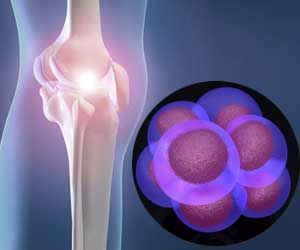Hoping to avoid surgery, Beals, 72, opted instead for an experimental treatment that involved harvesting bone marrow stem cells from her hip, concentrating the cells in a centrifuge and injecting them back into her damaged joints.
“Almost from the moment I got up from the table, I was able to throw away my cane,” Beals says. “Now I’m biking and hiking like a 30-year-old.”
More than one third of the American population suffers from knee pain—and this percentage, as well as the severity of the pain, nearly always increases with age.[1]
There are many causes of knee pain including:
injuries
mechanical problems (such as IT band syndrome)
arthritis (osteoarthritis, rheumatoid arthritis, gout, and septic arthritis lead to knee pain)
excess weight
lack of flexibility
genetic factors
In all of these cases, though, the result is the same: knee pain can adversely impact one’s quality of life, and is even completely debilitating for some people.
More than 600,000 people undergo knee replacement each year in the United States alone
For this reason, more than 600,000 people undergo knee replacement each year in the United States alone. Demand for the procedure is steadily rising, and half of all patients are under the age of 65.[2]
Many people obviously feel that total knee replacement is their only chance to find relief from their pain and reclaim a life of mobility—but this doesn’t mean that the procedure is done without risks.
In fact, despite its widespread practice, knee replacement carries many potential side effects and complications, including severe pain, scar tissue formation, bleeding, wound hematoma, infection, dislocations and fractures, nerve and other tissue damage, and even life-threatening blood clot conditions like deep vein thrombosis (DVT) and pulmonary embolism.
Even if no complications occur, recovery from knee replacement is very lengthy— with swelling and pain possible for the next six months. This may feel like the only option for some people…but it’s certainly not a great one.
A cutting-edge, risk-free alternative
The momentum of mainstream medicine can be a difficult thing to overcome. When you’re in the throes of a medical issue, deviating from the norm can be a scary choice to make—but those who do are sometimes rewarded.
This is certainly the case for the growing number of people who swear by stem cell therapy, which is now being offered as an alternative to knee replacement.
Here’s how it works: stem cells are able to differentiate into any other type of cell, and when injected into injured knee joints, studies suggest that they turn into chondrocytes, the cells responsible for producing and repairing cartilage.
To carry out this futuristic-sounding process, doctors simply harvest stem cells from elsewhere in the body (often from bone marrow, and sometimes even from fatty tissue). The stem cells are then concentrated using a centrifuge and sometimes added enzymes, both of which separate the cells from fat and other tissue that may have been collected. The stem cell preparation is then left to “incubate” for a short period of time, and then injected into the ailing knee to do its work.
All of this may sound strange (and you may very well prefer to avoid large, hollow needles), but don’t stop reading yet. Scientists are still trying to decipher exactly how stem cell therapy works its magic, but one thing is clear: for many people, it’s an absolute godsend.
Stories abound of nearly instantaneous relief from knee pain. The procedure is performed on an outpatient basis (as opposed to knee replacement surgery, which often requires a hospital stay of at least three to five days), and many patients are up and moving 24 hours after their first treatment.
This is a far cry from the weeks or months that knee replacement patients spend waiting for full recovery!
The number of stem cell clinics in the United States has jumped from 27 to a whopping 570 in recent years.
As more and more people flock to this promising treatment, doctors have risen to the demand—the number of stem cell clinics in the United States has jumped from 27 to a whopping 570 in recent years.[3]
Many of these doctors are in awe of the new modality, despite criticism from academic scientists, who say that proper studies haven’t been conducted to ensure the safety and efficacy of the practice.
It’s hard to ignore results, though. Kristin Comella, chief science officer of a stem cell practitioner training company called U.S. Stem Cells, echoes this sentiment: “We literally have patients who have come out of wheelchairs and are walking again.”[4]
So what’s the catch?
Leading stem cell researchers and clinicians maintain that stem cell therapy carries almost no risks. There’s hardly any risk of infection (because the procedure is not invasive) or rejection (because it’s your body’s own cells that are being injected into the knee), and the quick recovery leaves little room for lingering complications.
From a practical perspective, the only real drawback is the cost. Because the treatment is not FDA-approved, it’s not covered by insurance—and it usually costs around $7,000 for a treatment.
If you can swing this price tag, it may be worth meeting with a stem cell therapy practitioner to see if the treatment is right for you. Stem cell therapy has already changed many people’s lives for the better; if you’re thinking about knee replacement, be sure to consider it as an alternative.
The reticence of mainstream academic and researchers is certainly enough to warrant doing your homework before diving in, but all signs point to this treatment being the wave of the future.
References
[1] http://www.osteopathic.org/osteopathic-health/about-your-health/health-conditions-library/pain/Pages/chronic-knee-pain.aspx
[2] http://www.anationinmotion.org/value/knee/
[3] http://www.mensjournal.com/health-fitness/articles/does-stem-cell-therapy-actually-work-w437788
[4] Ibid.






